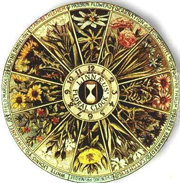
Linnaeus Flower Clock
guest post at wondersandmarvels.com
Recently, when I was reading from my novel Conceit, an experienced gardener asked whether the flower clock, used by Ann More to tell time, would actually work. In Conceit, it’s summer 1599, Ann is living in York House on the bank of the Thames in London, and she is having an erotic conversation with the poet John Donne.
I was inspired to write the scene by reading two of Donne’s poems. In Elegy 7, the poet says, “I had not taught thee then the alphabet of flowers.” In “A Lecture upon the Shadow,” the lovers take a long walk, discussing “love’s philosophy,” in which “our infant loves did grow.” Investigating further, I discovered that some flowers are aequinoctales that wake up and go to bed at the same time each day. I assumed that Ann, a well-bred girl of fifteen, had time to observe the opening and closing times of flowers, as well as the visiting times of bees, whereas the 27-year-old Donne, a secretary to the Lord Keeper of England, was too busy with affairs of state.
Before I named any plants, I had to be sure that they actually existed in England in 1599, so I paid a visit to the chronological bed in the Cambridge University Botanic Garden to check. I also researched the common names and habits of English flowers in John Gerard’s Historie of Plants, published in 1597. Some of the plants have charming names, such as Lady’s Nightcap and Jack-Go-to-Bed-at-Noon. From these and other sources, I chose several flowers that suited Ann and John’s love talk and the scene in chapter 8 of Conceit was born.
Not long after Ann and John took that walk in the York House garden, they eloped. Her father was incensed and she forfeited her dowry. Donne lost his job and was thrown in Fleet jail. It was then he was rumoured to say, “Ann Donne. John Donne. Undone.”
